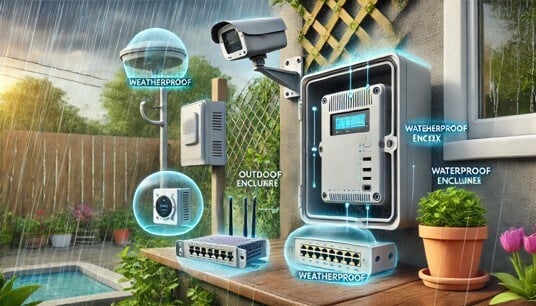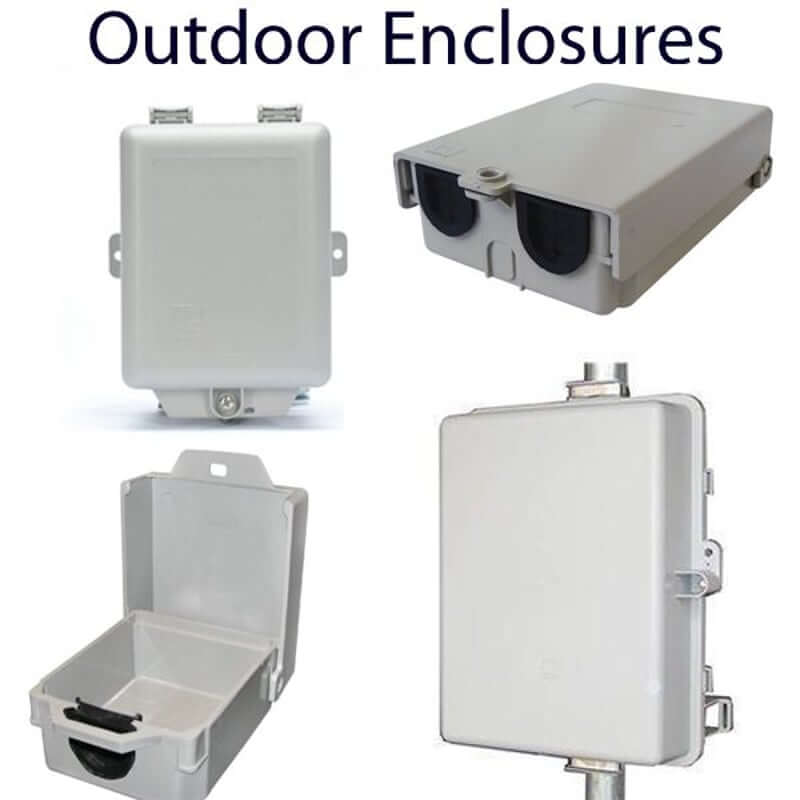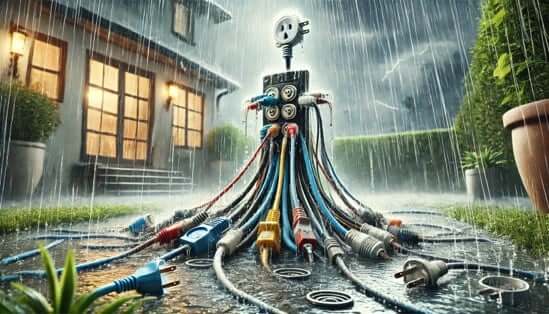Antennas, Antenna Cables, Wireless Products: Technical Articles
Waterproofing and Weatherproofing: Protecting Outdoor Electronics From the Elements
Waterproofing and Weatherproofing:
People bring electronic devices outdoors very often, from mobile phones to cameras to sound systems. For many, doing so is necessary. Some might not even think too much about bringing devices outdoors.
However, exposure to natural elements, like rain, heat, and dust, can damage these devices and cause them to break down.
Thus, it is essential to protect electronic equipment from the elements. In addition, there are ways to detect leaks or intrusions in electronics, like environmental sensors or water leak detection cables.
This article discusses how people can protect their electronic devices and equipment from water and weather damage.

How Weather Elements Can Damage Your Electronics:
Water
While it is widely known that water and electronics should not come together, the impurities found in water are what cause short circuits. Water damage can also corrode metal parts and circuit boards.
Fortunately, in most cases, electronic devices can recover from water exposure. Simple recovery steps include immediately turning the device off, removing the battery, and air-drying the device from several hours to a few days.
Heat
Electronic devices need some amount of heat to operate efficiently. For example, hard drives have moving parts that require lubricants to function correctly. Without enough heat, the lubricant might freeze up, and the parts might not move properly.
However, high temperatures can cause some parts to overheat, deform, or even melt. Therefore, devices need to maintain just enough heat to operate normally.
Dust
Many electronic devices have small openings meant for ventilation. However, these openings can be entry points for the dust to enter.
When dust penetrates the device, the dust can damage or scratch internal parts. It can also build up and cause the device to overheat.
Ways to Waterproof and Weatherproof Outdoor Electronics:
Use Water- or Weatherproof Cases or Enclosures
 Cases or enclosures made from suitable materials can prevent or minimize the device’s exposure to weather elements.
Cases or enclosures made from suitable materials can prevent or minimize the device’s exposure to weather elements.
For example, poly-carbonate enclosures prevent the sun’s UV rays from heating the device. A tightly sealed poly-carbonate box can prevent water from penetrating and damaging the equipment stored inside.
Another example is cell phones. A reliable cell phone case can prevent or minimize shock damage caused by falling or being dropped. A well-sealed case can also prevent water damage.
There are also simple solutions to proof your devices. You can use a resealable, waterproof bag to store your cell phone or camera when you go to the beach. This solution can already significantly reduce your device’s exposure to the elements.
Protecting Cable Connections Outdoors
While enclosures and cases shield the electronics themselves, it's important to remember that weatherproofing extends to the cables that connect them, especially for antennas.
Several RF cable types are commonly used for antennas, including U.FL, MHF4, SMA, MMCX, and RP-SMA cables. These cables often have specialized connectors that can be susceptible to corrosion or water damage if exposed to the elements.
Whenever possible, use weatherproof versions of these cables for outdoor applications. Look for cables with sealed connectors or those designed for outdoor use.
If you're using adapters for antenna cables (like RP-SMA to U.FL or SMA to U.FL), ensure their weatherproofing is adequate, especially if connecting between non-weatherproof components.
By following these tips, you can ensure a complete weatherproof solution for your outdoor electronics and antenna setups.
Use Canopies or Tents
For large equipment like speakers for outdoor concerts, canopies are a simple solution to minimize weather exposure, especially from the sun and rain.
Canopies and tents prevent or minimize overheating associated with direct exposure to solar radiation, such as UV light. Canopies also prevent water damage by keeping rain and even snow away from the equipment.
To some degree, this protective layer can also minimize dirt damage.
Canopies and tents require some setup at the start but do offer sufficient protection.
Place Electronic Equipment Off the Ground
People can place large electronic equipment on top of boxes or elevated platforms. This method keeps the equipment off the ground and prevents dust and dirt from sticking to the equipment.
For example, sound systems like large speakers can be protected by placing them on elevated platforms or wooden crates if the soil is dusty or if there is rainwater on the ground.
Place Cables Underground
There are times when electronic devices such as security cameras and lampposts need to be installed outdoors. These devices need permanent wiring to get a power supply.

Wires laid above ground risk exposure to weather and water damage. Other forms of damage can come from people, animals, and even vehicles.
When wires placed above ground are damaged, they can cause additional risks such as fire hazards and safety concerns.
To prevent wires and cables from getting damaged and causing accidents, they should be installed underground. By doing this, risks associated with above-ground wires are significantly reduced.
Underground wiring might be a little costly and require some effort to set up. Still, underground wires and cables are protected from most environmental and man-made risks in the long term.
In Conclusion
Electronic devices are susceptible to damage from many environmental elements, so there is a need to protect them by methods such as waterproofing and weatherproofing.
There are simple methods to proof electronic devices from the elements— like using a ziplock to store your cell phone when you go swimming. Still, water- and weatherproofing them can be a significant investment.
For example, a sturdy canopy or a weatherproof poly-carbonate enclosure can cost a significant amount of money. Even digging up to install underground wiring requires some materials and effort.
Review and assess your electronic devices and determine which ones you need to water- or weatherproof. For example, getting a waterproof case for your laptop isn’t as costly as buying a canopy, and therefore more doable.







